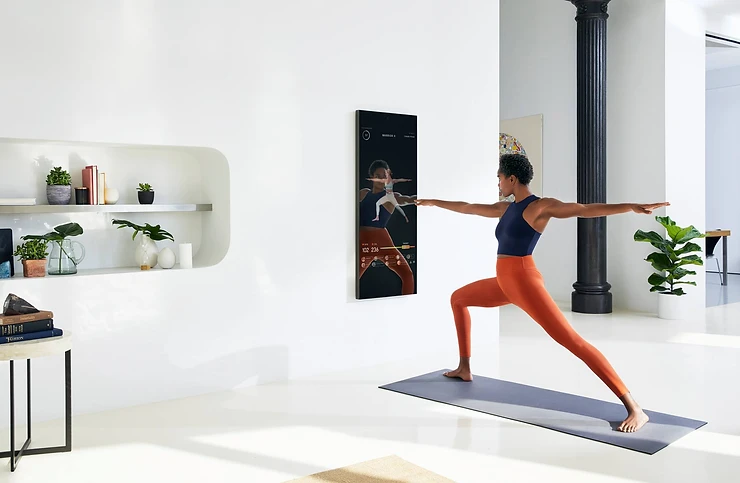
Virtual fitness classes have grown past the novelty phase, with millions of people using apps and internet-connected gear to exercise at home. Gyms are fighting back.
Cara Casano used to go to a gym in Monroe, N.Y., four days a week for spin or body-sculpt classes. But after having a baby in January, she had trouble arranging child care for gym time.
Instead, she bought a Peloton high-tech stationary bike to give at-home exercise a try. When she clipped in for a live-streamed virtual group ride, she was surprised by how much it felt like a real class. The bike’s display screen showed other riders and the instructor sometimes called people out by name. Ms. Casano, 32, joined a Peloton new moms’ group on Facebook.
“People are always posting questions like, ‘Who’s riding tomorrow? Who wants to do this type of musical ride or that type of ride?’ And you start riding with them,” she says. In June, she dropped her gym membership.
At-home virtual fitness programs have grown past the novelty phase, with millions of people using apps and internet-connected gear to do home workouts that try to mimic the buzz and energy of an in-person class. Gyms are taking notice, launching their own at-home programs: Last week Equinox, the owner of SoulCycle, announced it will debut a streaming service in the fall. The company didn’t mention competitors, but said the move reflects members’ wishes “to choose where, how and when they work out.”

Spin studio Flywheel is ramping up virtual offerings after launching its own connected stationary bike, Fly Anywhere, in late 2017. Gold’s Gym is expanding its Amp virtual programming, as is Crunch’s Crunch Live.
U.S. gym membership hit an all-time high in 2018, but the rate of growth cooled to 2% after a 6% rise the year before, according to the International Health, Racquet & Sportsclub Association. Much of the decade’s growth has been fueled by boutique studios like CrossFit, Orangetheory and SoulCycle, whose ability to turn fitness into a communal experience has sparked fierce loyalty to their brands. IHRSA says it’s too early to tell whether streaming classes will reduce club visits. CrossFit, SoulCycle and Orangetheory say they don’t see at-home streaming fitness programs as a threat.
At-home fans say they like the convenience of working out when and where it suits them. And unlike past home fitness fads that forced people to generate their own motivation, these new technologies provide virtual competitions, online communities and electronic alerts that nudge you to exercise.
Virtual workouts can be a good option for people who crave some level of group connection but feel self-conscious in a real class, says Walter Thompson, a professor of exercise psychology at Georgia State University in Atlanta. But his research shows that home programs are most effective when they nudge the user to act. “If it’s just an app that exists on your phone, it’s relying on you to make a choice to go in and open it,” he said. “But if my Apple watch goes off with a prompt telling me it’s time to stand, I’ll do it.” Many of the new programs have notification options or will add a class into the user’s calendar.
Peloton, whose touch screen gives access to live and on-demand spin classes, lets people compete virtually against other riders. Launched in 2012, Peloton counted more than 500,000 subscribers in early 2019, double the number from a year ago, and recently filed to go public. The bike costs about $2,000, plus a $40 monthly subscription.
Mirror Home Gym started selling its vertical LCD screens last year. When idle, it looks like a full-length mirror, but when switched on, it becomes a virtual fitness center with live and on-demand classes led by instructors who appear on screen. Thumbnail photos show other users taking the class, and members interact with instructors and each other on Facebook and Instagram. The Mirror costs about $1,500, plus a $40 monthly subscription fee. The company hasn’t released subscriber numbers, but said in February it’s been selling $1 million worth of mirrors a month.

Fitness app DailyBurn offers hundreds of workouts ranging from yoga to strength-training, through live and on-demand classes; subscriptions range from $10 to $20 a month. Current subscribers number in the hundreds of thousands, according to CEO Tricia Han. The Aaptiv app, launched in 2016, offers trainer-led audio workouts to more than 230,000 subscribers, a 45% increase over last year. The app offers team challenges, a virtual coach to set your workout schedule and electronic reminders.
Anne Napolitano, a 55-year-old accountant, used to take kickboxing classes three times a week at a gym in Bethpage, N.Y. But she couldn’t stick to the schedule when she started her own business. She signed up for DailyBurn’s free trial and promised herself she’d work out at 5:30 every morning.
At first, she didn’t take her new commitment seriously. “There were a lot of days when I found it very hard to motivate myself when that alarm went off,” she says.
But then she joined the app’s Facebook group. When one member challenged others to work out every day for two straight months, Ms. Napolitano jumped in—and it became a habit, she says. She ditched her $150 a month gym membership and pays less than $75 annually for the app subscription.
Her current favorite class, which she streams to her living room TV, is the Daily Burn 365, a morning workout hosted by television personality JD Roberto. Users post comments in the show’s Facebook group about that day’s workout. “It gets you excited to go home and do the class because you don’t want to miss out on anything,” she says.
Being part of a group helps to boost performance, says Dr. Eric Bean, a sports psychologist in San Diego. “Previously, working out at home meant working out alone. But now I get that group effect of being in a class where others can see me and I can see how I compare to them,” he says.

Brynn Putnam, Mirror’s founder and CEO, is playing both sides. A former ballerina with the New York City Ballet, she opened her first boutique fitness studio in New York in 2010 blending ballet, Pilates and yoga with high-intensity strength and interval training. She called her program the Refine Method and now has three studios.
Many of her Refine Method members have purchased Mirror devices only to discontinue their studio membership, she says. “I didn’t set out to put my studios out of business, but I’d be happy if I did because I believe people’s fitness goals are better served by working out at home,” she said.
Michelle Lechner, 48, of Stamford, Conn., bought a Mirror in October, after years of taking four fitness classes a week at a local gym. She says the at-home sessions don’t offer quite the same level of urgency as a gym class. “You have to motivate yourself to go turn the thing on,” she says.
But she loves the flexibility and convenience of home workouts. She dropped her $180-a-month gym membership and says she’s actually exercising more often now. “Sitting in a class and having somebody sneeze and cough all over me, waiting for the shower, forgetting to pack things for work, the driving—I don’t miss any of it,” she says. “It’s nice not to plan my life around a class.”


